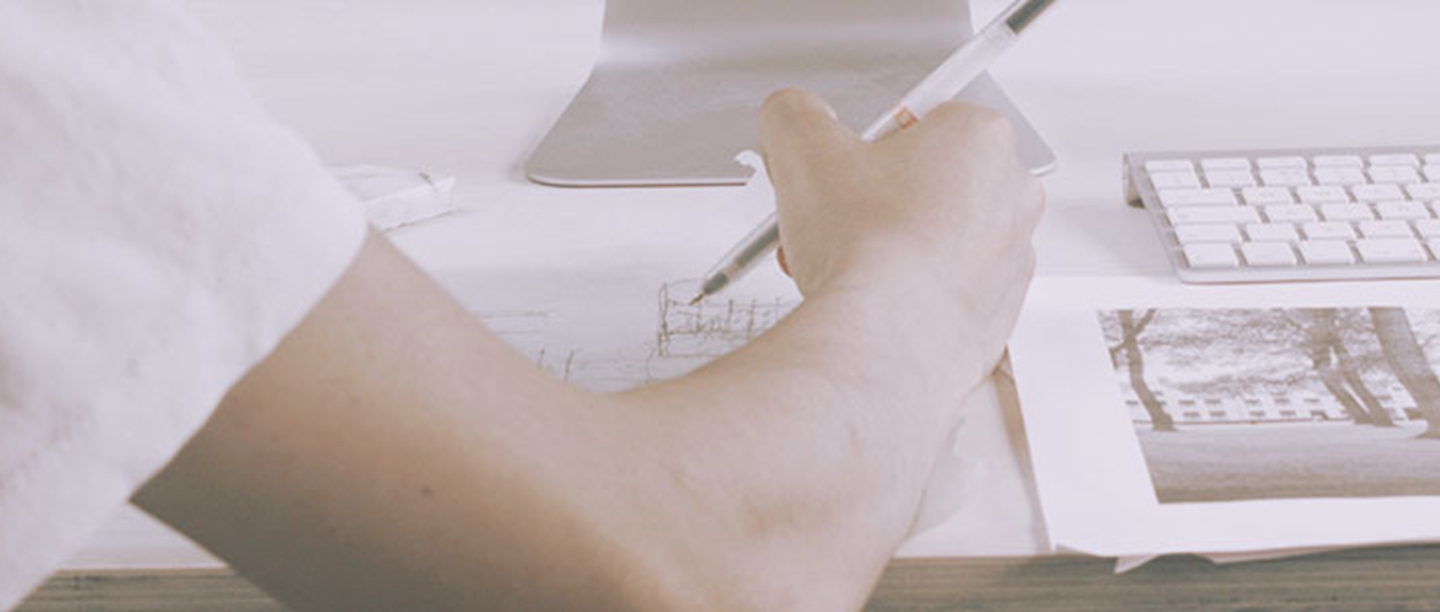
How do you transform the ruins of a building into detailed drawings? Architects Jon Lopez and Hikaru Nissanke have recently designed new reconstruction drawings for Rievaulx Abbey, which give visitors an impression of how the abbey would have looked in its heyday. We spoke to Jon to find out more about the process.
Where did you start for the Rievaulx project?
Jon Lopez: We worked with Stuart Harrison, who is an expert on Rievaulx Abbey. He would check things for us, and people from English Heritage would discuss the faithfulness and the style of the reconstructions. It is a process of refinement to create the final images.
Visiting the place is also very important – even if half of it is just ruins of walls two or three feet high, you still get a sense of scale and proportion from using your body to measure things in a sense.
L: The refectory at Rievaulx Abbey today, R: The reconstructed image of the refectory as it was in Rievaulx’s heyday,
created by Jon and Hikaru in consultation with English Heritage historians.
Have you worked on reconstruction drawings before?
JL: This is the first set of reconstruction drawings that we’ve done. We’ve been practicing as architects for the last five years, and teach design at Cambridge and Central St. Martin’s.
It was familiar in some ways but quite unfamiliar in other ways. We’ve never worked with archaeologists to draw before so it was quite a challenge to understand the fragments of things that remain and position them within a context.
How do you develop the images?
JL: The images are created using a hybrid of digital and manual techniques. We began by sketching and tracing ink drawings from Stuart Harrison’s book. This helped us think about how we might show various parts of the abbey.
Then we scanned those drawings into the computer and drew them using a CAD (computer-aided design) programme, before modelling it in a 3D programme. After that we composed everything in Photoshop, which we use for drawing.
Jon and Hikaru use CAD programs and Photoshop to recreate buildings digitally. The Rievaulx Abbey interpretation
images are the first time they’ve tackled historic reconstructions.
We use Photoshop as a kind of digital collage, where you compose things in layers and use effects, almost like you are painting in Photoshop. So the final drawings are the result of a combination of different techniques.
How much room for imagination is there for people looking at the drawings when they visit the site?
JL: I like the idea of having a looseness and ambiguity to an image so that people can project their own viewpoints onto them. Because each person will experience the physical place in a unique way, I would hate to restrict someone’s interpretation or imagination.
The images are not intended as a photographic document of the place, but rather a representation of a current discourse and understanding about the abbey.
We like it when we present our drawings to people and they can understand different things about them, maybe things that we didn’t even expect. We want visitors to project their own understanding onto the image rather than it being a didactic tool.
Compared to architectural drawings, where the work may get built, these reconstruction drawings will always remain on paper. Does it change how you work and draw?
JL: Our architectural work is split between doing speculative projects and things that actually get built. So we see a lot our work get built, but a lot will always remain a drawing.
In a sense those drawings have different functions: for things that get built the drawings are almost a set of instructions to a builder, whereas propositional drawings have to describe the material quality or texture or something to describe its physicality because you know it is never going to get built.
Reconstruction drawing of the Cistercian monks at Rievaulx Abbey processing into the nave for a service.
How do you think reconstruction drawings can help people better understand history?
JL: We’ve recently been looking a lot at Piranesi’s [an 18th century Italian artist] reconstructions. He often combined studies and drawings of what was left with idealised reconstruction over the top.
This means they are not just a snapshot of what was happening at that particular time, they become a reflection on contemporary issues and problems. I think that is much more interesting than just saying ‘this is what it was like in the 15th century’. You can use it as a learning tool, rather than it being fixed in time.
Are there other historic sites you would like to make reconstructions for?
JL: Rather than a particular site, what interests us the most is uncovering the form of these places and objects.
It’d be great to work on a project where there is only written information, with no existing drawings or surviving physical objects. There is a lot more fluidity in how you can interpret written information, and translating that information into a physical form and shape is something that is very intriguing.
Visit Rievaulx Abbey and see the drawings for yourself
The reconstruction drawings form a part of new interpretation now on display at Rievaulx Abbey, along with a new museum which helps us understand the lives of the monks who lived there.
Rievaulx Abbey is open daily 10am-6pm throughout summer.
The new museum at Rievaulx Abbey in Yorkshire is open now after a £1.8 million investment
project at the site.